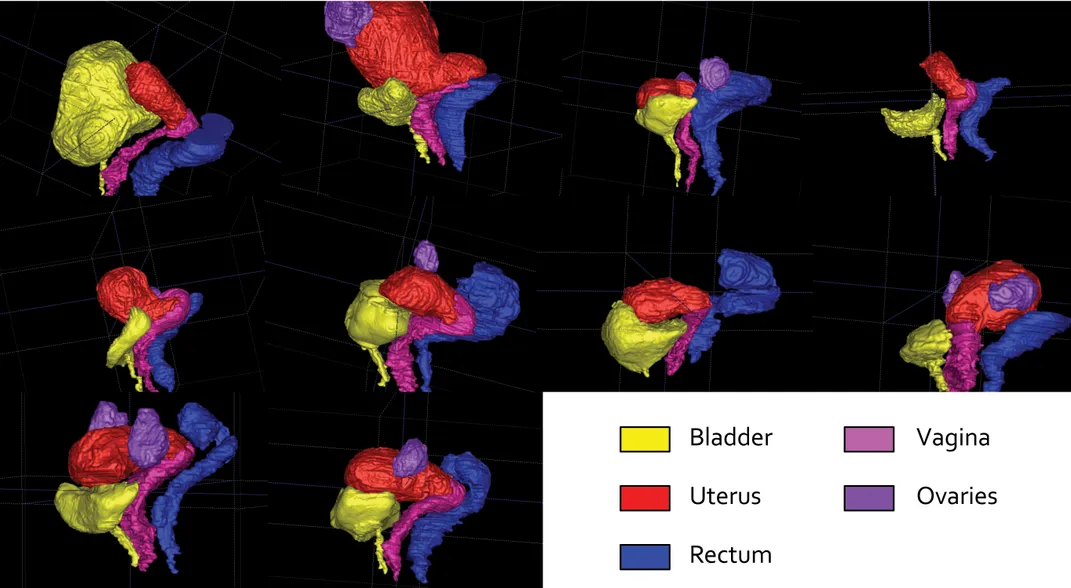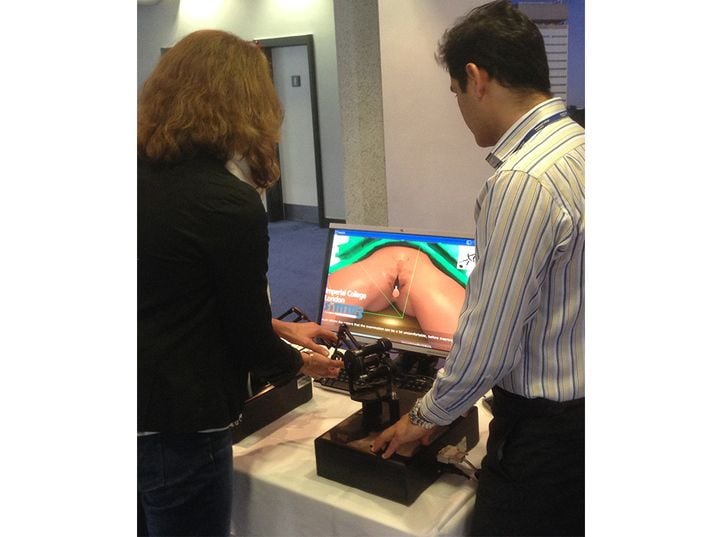The Quest to Build the First Robotic Vagina
Your reproductive tract is a biological miracle, and researchers are trying to recreate it
:focal(536x469:537x470)/https://tf-cmsv2-smithsonianmag-media.s3.amazonaws.com/filer/c3/8d/c38d27aa-c19f-4963-a21d-b76708c28107/georgia_okeeffe_series_1_no_8.jpg)
The female body is a complicated thing—just ask your doctor. Specifically, women’s reproductive systems exhibit a wide array of anatomical variation, and the bulk of our lady parts are tucked inside and invisible to the eye. This presents doctors-in-training with a daunting challenge: how to master the dreaded gynecological exam.
Although an influential health panel recently suggested healthy women may not need a full pelvic exam every single year, many doctors still see the annual exam as a critical opportunity to look for cancers, cysts, fibroids and more. Now, researchers at Imperial College London are creating a robotic female pelvis which would allow medical students to learn to “see” the female body by feel, so they’ll be more prepared when they encounter a live human being with her feet in stirrups.
If these researchers succeed, their funny-looking silicone recreation of the lower female torso could help new doctors get better—faster—at conducting the most intimate exam most women regularly face. It could also ensure that these doctors’ first exams are more comfortable for the women on the receiving end. The team’s project involves 3D imaging as well as haptic technology to simulate the sense of touch—a suitably complex project to simulate a complex facet of the human anatomy.
But even with cutting-edge techniques, it's a tough feat. The team has been working on the project for about five years, and they’re finding that there’s still a lot to learn about the female body. “It’s fascinating, really,” says Fernando Bello, a professor in surgical computing and simulation science who leads the team. “We’ve been working on this for a number of years now, and in many ways, we feel as if we’re kind of just beginning.”
It all started with a rectum. About 7 years ago, Bello’s team began developing a robotic male rectum to help medical students practice prostate examinations. It’s the exam men most fear, and it’s no picnic for med students and doctors either. With their model, the researchers wanted to make it easier for both parties by helping guide students to distinguish the “hard and knobbly” feel of a cancerous prostate from the feel of a healthy one.
That project ended up being more time-consuming than expected. Here’s how it works: a trainee puts a finger into silicone buttocks, where it slips inside a silicone thimble that is attached to robotic arms. Programmable technology creates a virtual anatomy, with variable degrees of pressure standing on for the coccyx, bladder, pelvic floor and prostate. (When a student's finger touches the prostate, for instance, more force could generate a more rigid feel, signaling a possible carcinoma.)
Meanwhile, a trainee wearing 3D glasses sees an image on a screen showing his or her finger in relation to all the body parts being learned by feel. A trainer—who would otherwise have little sense of the progress of the internal exam—can offer feedback based off what’s seen on the screen.

Managing to simulate the rectum right down to its pressure and resilience was already an impressive feat. But about 18 months into that project, Bello and his team started working on a robotic female pelvis. They quickly discovered that was going to be a lot harder than the first. “The female anatomy is more complex externally and internally, in many ways,” Bello says. “There is more significant variability and there’s a wider range of variables, as well.”
Most women are familiar with the bimanual pelvic exam, in which a doctor uses two hands— one inside and one outside your body—to feel around for the uterus, ovaries and other internal structures. The exam is meant to detect a variety of conditions like pregnancy, cancer and endometriosis before women actually develop symptoms, says Sandra Carson, the vice president of education for the American Congress of Obstetricians and Gynecologists. The doctor tries to figure out: “Is the uterus soft, is it forward, is it tipped backward, is it enlarged, are there masses?” Carson says. The same visit can include a visual inspection and a pap smear, which identifies cervical cancer cells.
Currently, medical students learn how to perform these exams through a variety of methods, including simpler plastic simulators, live medical models who help guide students through their bodies, and real patients in a clinic setting. Bello is hoping his robotic pelvis—which works in the same way as the robotic rectum, with haptic technology and 3D imaging on a screen—will combine the real feeling of a human being with the ability to see a typically “unsighted” exam.
But creating technology that works with an external hand and two internal fingers is more difficult than accommodating the single finger required for a rectal exam, Bello says. To understand how doctors do it, Bello’s team had experienced gynecologists conduct exams with special gear on both hands: pads that detect pressure as well as electromagnetic sensors that relay location and movement. They also scanned healthy women to get images of their reproductive systems to base the models on.
The bimanual pelvic exam can also be more difficult to master than the rectal because “doctors have to look for the structures in a larger space,” Bello says. Tunneling up a man’s rectum to feel his prostate isn’t exactly simple, but it is more straightforward. Ovaries, on the other hand, can be a little more subtle.

“The ovaries are about the size of an almond,” says Elisa Jorgensen, a fourth-year OBGYN resident at Yale New Haven Hospital. “Especially with larger patients, it’s very, very difficult to feel them when there’s no pathology.” Jorgensen recalls a “stressful” experience when fellow students at Yale Medical School performed a pelvic exam for the first time, on live models specially trained in guiding newbies. “A lot of my classmates were saying by the end of the exam, ‘I was pretending I felt the ovary because I just wanted to get out of there.’”
It’s not just that the pelvic exam requires experience and skill. After all, there’s also technical skill required to listen to the heart through a stethoscope, points out Taraneh Shirazian, an assistant professor in obstetrics and gynecology at NYU Langone Medical Center. It’s also that the exam's invasive nature can be embarrassing to student and patient alike. Medical students honing their technique in a clinical setting are faced with the unenviable task of putting an anxious patient at ease, looking like they know what they’re doing and trying to incorporate their supervisor’s feedback, all at once.
Plus, they have to locate and examine a lot more organs than just the prostate. “There definitely are a lot of variables, if you will, to female anatomy,” says Shirazian. On a very overweight patient, for instance, even the uterus can be hard to feel. Scarring from a C-section can change the location of the cervix and uterus. And fibroids could push one ovary over to the side. “There are nuances,” she says, to put it mildly.
Carson of ACOG says the robotic pelvis could be a “fabulous” addition to medical education—provided it’s not too expensive. Bello and his team are now working on building an affordable version of their robotic rectum to sell to medical schools, and trying to attract funding to refine their prototype of the female pelvis. He’s hoping both will help new doctors better detect problems and perform intimate exams in a way that causes less discomfort for patients. At the moment, he says, “I think it’s very likely that there’s an element of learning on the job.”